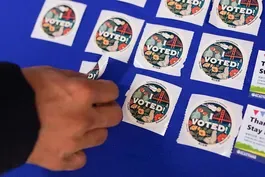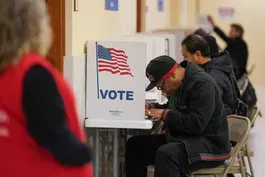
What's behind the stunning rise in alcohol-related deaths
Clip: 3/5/2024 | 5m 51sVideo has Closed Captions
What's behind the stunning rise in alcohol-related deaths
Alcohol is one of the most commonly used drugs in America, and it is also one of the deadliest, with more and more people losing their lives to alcohol-related causes over the last two decades. A new report reveals how the problem has become more acute in recent years. Keith Humphreys, a professor of psychiatry and behavioral sciences at Stanford University, joins William Brangham to discuss.
Problems with Closed Captions? Closed Captioning Feedback
Problems with Closed Captions? Closed Captioning Feedback
Major corporate funding for the PBS News Hour is provided by BDO, BNSF, Consumer Cellular, American Cruise Lines, and Raymond James. Funding for the PBS NewsHour Weekend is provided by...

What's behind the stunning rise in alcohol-related deaths
Clip: 3/5/2024 | 5m 51sVideo has Closed Captions
Alcohol is one of the most commonly used drugs in America, and it is also one of the deadliest, with more and more people losing their lives to alcohol-related causes over the last two decades. A new report reveals how the problem has become more acute in recent years. Keith Humphreys, a professor of psychiatry and behavioral sciences at Stanford University, joins William Brangham to discuss.
Problems with Closed Captions? Closed Captioning Feedback
How to Watch PBS News Hour
PBS News Hour is available to stream on pbs.org and the free PBS App, available on iPhone, Apple TV, Android TV, Android smartphones, Amazon Fire TV, Amazon Fire Tablet, Roku, Samsung Smart TV, and Vizio.
Providing Support for PBS.org
Learn Moreabout PBS online sponsorshipGEOFF BENNETT: One of the most commonly used drugs in the U.S. is also one of the deadliest.
That's alcohol.
Over the last 20 years, more and more Americans have died from alcohol-related causes, and a new study reveals how those deaths have surged recently.
William Brangham takes a closer look.
WILLIAM BRANGHAM: The CDC issued this new report, and it looks at both deaths directly tied to alcohol, like cirrhosis of the liver, as well as indirect deaths, like injuries and certain types of cancer.
It found that, in just five years, alcohol-related deaths rose by 29 percent.
By 2021, alcohol contributed to the deaths of more than 178,000 Americans that year.
That's about 500 people a day lost because of consuming wine, beer, or other alcohol.
For a broader look at these findings, we're joined again by Keith Humphreys.
He's a professor of psychiatry and behavioral sciences at Stanford University.
Keith, very good to have you back on the "NewsHour."
Were you surprised?
I mean, this is your field of study.
Were you surprised by these numbers and how much they had ticked upwards?
KEITH HUMPHREYS, Professor of Psychiatry and Behavioral Sciences, Stanford University: Sadly, I am not.
We noticed during the pandemic that certain groups of the population were increasing their drinking, including drinking alone and drinking in large amounts.
And, also, there's been a long-term trend.
Although cost of living is going up for many things, it is not for alcohol.
Alcohol is very cheap in the United States right now, in historical terms.
And when it's cheap, Americans tend to drink more, and that's where you get, unfortunately, these kinds of really tragic numbers.
WILLIAM BRANGHAM: And are those the principal drivers, low price and all the stresses associated with the pandemic?
KEITH HUMPHREYS: Those two things are absolutely critical to producing this kind of increase.
I mean, we have -- federal alcohol taxes were last increased in 1991.
They have been declining in real terms ever since.
Alcohol taxes on craft beer and spirits were actually cut just before the pandemic.
And that has always historically driven more consumption.
The other point to remember, of course, is that alcohol is a legal product and therefore one that is heavily advertised.
And we do know that the amount of promotion of alcohol, which anyone who has watched a football game is aware of, also helps keep the business flowing and keeps people drinking, including sometimes, unfortunately, too much.
WILLIAM BRANGHAM: I mean, I can't help but notice -- you and I have talked many times over the years, but we're always talking about illicit drugs, illegal drugs and policies to address those, never about alcohol.
I mean, is that just like, as Orwell says, that the struggle is constantly to see the thing that is right there in front of us?
KEITH HUMPHREYS: Yes, it's a huge blind spot in American drug policy.
You can talk about drugs for hours, and people will mention fentanyl and meth and cocaine, which are, of course, very important drugs to think about, and they do a lot of harm, but no one will bring up alcohol.
And, afterwards, they may all get a drink together and not even think, we're using a drug right now.
And that's partly what the risk of alcohol comes from, is that those who use it don't think of themselves as using a drug and, therefore, they don't worry about it as much as they should.
WILLIAM BRANGHAM: One of the things, back into the CDC's data, while more men died of alcohol-related deaths, the death rate increased for women quite dramatically.
Why do you think that is?
KEITH HUMPHREYS: Very tragic to see the increase among women's deaths.
And, also, it's enraging to know where it comes from.
So, about 25 years ago, the alcohol industry observed that women were getting more education, more disposable income, but they weren't drinking that much.
So they launched quite a bit of female-focused advertising, creating, for example, mommy wine culture and that sort of thing.
And it worked, broadly speaking.
We saw an increase in women's drinking, including in some populations drinking as much as men.
And, biologically, the same amount of alcohol in general actually is more damaging to women than men, partly to do for reasons of metabolism, partly to do with reasons of body size.
And so we're seeing the awful outcome of a 25-year-long campaign to get women to drink more heavily.
WILLIAM BRANGHAM: So, in terms of solutions, what do we know that works on a policy level?
I mean, you touched on some of these things, price being one of them, but what else can we do as a society to try to ameliorate these ills?
KEITH HUMPHREYS: Yes, sometimes, the simple answer is the right one.
Alcohol is a commodity, like gasoline.
People use less of it when it's more expensive.
So, simply indexing alcohol taxes for inflation, so they don't lose value over a year, that would reduce people's drinking.
We have very good demonstrations of that fact in states and nations that have done it.
WILLIAM BRANGHAM: And what about individuals?
If someone personally feels like, you know what, I am concerned about this, what do we know works?
KEITH HUMPHREYS: So, one thing I can say with optimism for anyone who's out there struggling with a drinking problem is, there's about 23, 24 million Americans who have had a serious problem with alcohol or other drugs and are in recovery.
Recovery is a realistic aspiration.
It happens every single day.
There's no one right pathway to it.
There are people who benefit through Alcoholics Anonymous, the mutual health program.
There's people who benefit from treatment, from counseling.
There's people who benefit from medications.
There's also people who are able to change without any of those things, usually with some reorientation in their life, like engaging with people who don't drink and activities that are incompatible with drinking.
So there's every reason to believe that you can recover, and there's certainly no reason to feel ashamed if you have a drink problem.
It's something that millions and millions of Americans will go through.
WILLIAM BRANGHAM: All right.
Keith Humphreys of Stanford University, always so interesting to talk with you.
Thank you very much.
KEITH HUMPHREYS: Thank you.
Austin theater company preserves Latin American culture
Video has Closed Captions
Austin theater company works to preserve Latin American culture (2m 55s)
‘Burn Book' explores a life covering the tech industry
Video has Closed Captions
‘Burn Book' explores Kara Swisher’s life and complicated relationship with tech industry (6m 58s)
California voters decide consequential U.S. Senate race
Video has Closed Captions
California voters decide consequential U.S. Senate race (6m 32s)
Family members of hostages give opposing views on Gaza war
Video has Closed Captions
Family members of hostages offer opposing perspectives on war in Gaza (9m 55s)
How Super Tuesday may impact the 2024 presidential race
Video has Closed Captions
How Super Tuesday may impact the 2024 presidential race (8m 42s)
Providing Support for PBS.org
Learn Moreabout PBS online sponsorshipSupport for PBS provided by:
Major corporate funding for the PBS News Hour is provided by BDO, BNSF, Consumer Cellular, American Cruise Lines, and Raymond James. Funding for the PBS NewsHour Weekend is provided by...
















